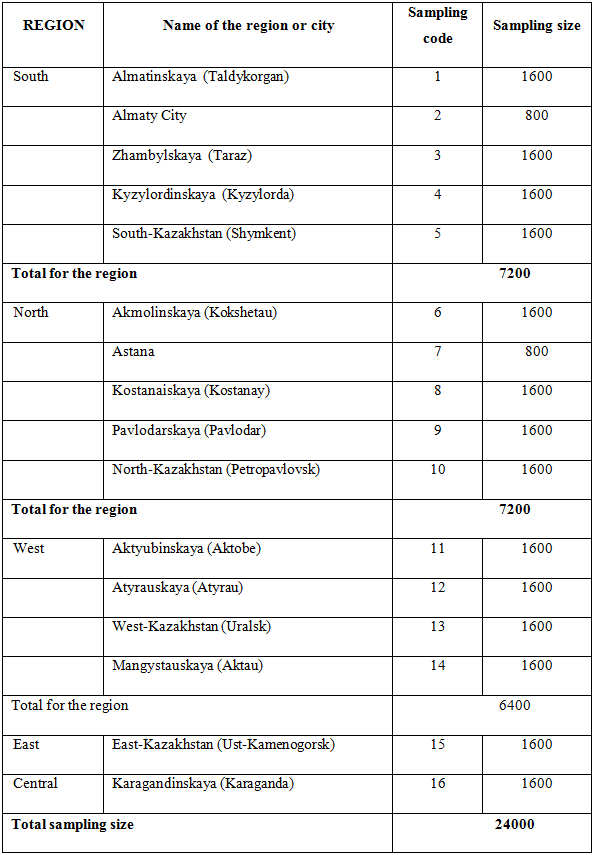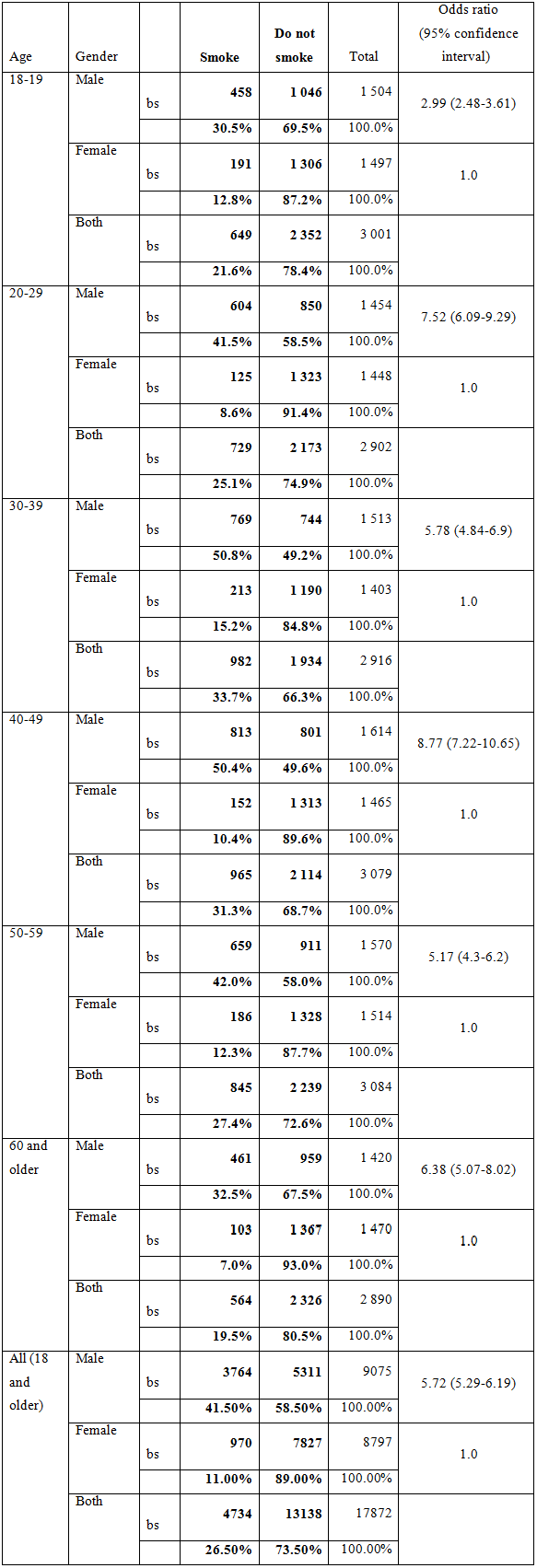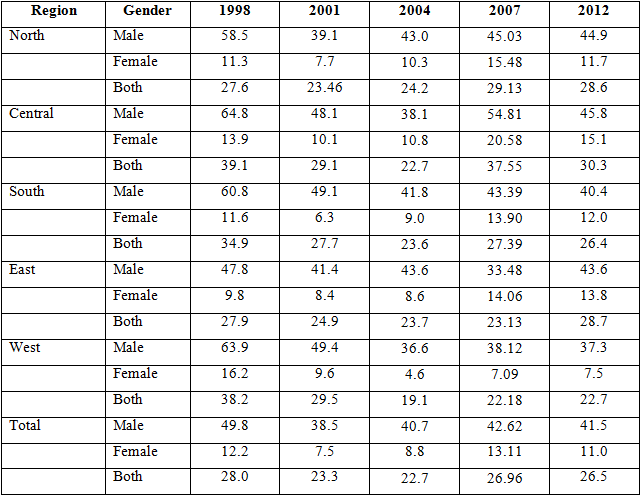EPIDEMIOLOGICAL SURVEILLANCE AND MONITORING OF TOBACCO CONSUMPTION PREVALENCE IN THE REPUBLIC OF KAZAKHSTAN
Баттакова Ж.Е.1, Адаева А.А2, Ермухамбетова Т.Н. 3
1Доктор медицинских наук, профессор, 2Магистр, 3Магистр, Национальный Центр проблем формирования здорового образа жизни, Республика Казахстан, Алматы
ЭПИДНАДЗОР И МОНИТОРИНГ РАСПРОСТРАНЕННОСТИ УПОТРЕБЛЕНИЯ ТАБАКА В РЕСПУБЛИКЕ КАЗАХСТАН
Аннотация
Фактические данные показывают, что антитабачные меры являются доступными в Республике Казахстан. В исследовании представлены процессы реализации стратегии Всемирной организации здравоохранения (далее – ВОЗ) по мониторингу распространенности потребления табака среди населения в динамике последнего десятилетия, а также принятия национальных правовых актов по повышению осведомленности о табачной зависимости и пагубном воздействии на здоровье, направленные на сокращение потребления, эффективность которых будет оценена по результатам научного исследования с международным участием (GlobalAdultTobaccoSurvey – GATS) в текущем году.
Ключевые слова: ВОЗ, табак, распространенность курения, мониторинг потребления табака, профилактика.
Zh.E. Battakova1, A.A. Adayeva2 , T.N. Yermukhambetova3
1Doctor of Medical Sciences, professor, 2Master of Medical sciences, 3Master of Medical sciences National Centre for Problems of Healthy Lifestyle Development under the Ministry of Health and Social Development of the Republic of Kazakhstan, Almaty city
EPIDEMIOLOGICAL SURVEILLANCE AND MONITORING OF TOBACCO CONSUMPTION PREVALENCE IN THE REPUBLIC OF KAZAKHSTAN
Abstract
The actual information shows that antismoking measures are accessible in the Republic of Kazakhstan. The study describes the processes of implementation of the World Health Organization (WHO) strategy on monitoring of the tobacco consumption prevalence among the population in the dynamics of the last decade and acceptance of the national legal acts on increase of the awareness about tobacco addiction and adverse health effect aimed at the consumption decrease, which efficiency will be evaluated according to the results of the scientific study with the international participation (Global Adult Tobacco Survey – GATS) in the current year.
Keywords: WHO, tobacco, smoking prevalence, monitoring of tobacco consumption, preventive measures.
The tobacco consumption continues to be the main global cause of the avoidable mortality. Worldwide it annually kills almost six million persons including more than 600 000 nonsmoking persons, who die from the influence of the secondhand tobacco smoke, and it entails the economic loss of hundreds billions of dollars. At the present time an increasing epidemic of noninfectious diseases is registered worldwide, first of all they are cancer, diabetes, cardiovascular and chronic pulmonologies, which cause 63% of all cases of deaths in the world. Every year this group of diseases kills 36 million persons, and the biggest contribution to it is made by the tobacco consumption. With the current trends by the year 2030 the tobacco will annually kill over eight million persons all over the world, and 80% of these untimely deaths will fall at the population in the countries with low and medium income levels. If no immediate actions are taken, during the 21st century the tobacco consumption can kill a billion of persons and more (WHO Report on the Global Tobacco Epidemic, 2011) [1-5].
Kazakhstan demonstrates the political will for strengthening of the tobacco control, taking measures reducing the demand for tobacco products, and introduction of effective national antismoking preventive, lifesaving strategies. An effective instrument, which allows achieving progress in implementation of the antismoking policy in Kazakhstan, is the WHO Framework Convention on Tobacco Control (WHO FCTC). Together with 179 countries ratified WHO FCTC, the country successfully performs its international obligations on introduction of measures of tobacco smoking control for the benefit of the public health, in 2006 Kazakhstan passed the Law “On Ratification of the WHO Framework Convention on Tobacco Control” (Zh.Ye. Battakova, 2014) [6-11].
After adoption of WHO FCTC, in 2008 the WHO introduced MPOWER – a set of six antismoking measures, which include monitoring of tobacco use and prevention policies (М); protection of people from tobacco smoke (Р); offering help to quit tobacco use (О); warnings about the dangers of tobacco for health (W); enforcement of bans on tobacco of advertising, promotion and sponsorship; (Е) raising excise taxes on tobacco products (R).
Among the effective national antismoking prevention strategies it is necessary to emphasize adoption by Decree of the Government of the Republic of Kazakhstan dated November 22, 2011 No.1366 of the Rules of Placement of the Information about Content, Concentration of Resinous Substance, Nicotine and Systemic Poisons, Cancerigenic and Mutagenic Substances and Warnings about Dangers of Smoking on the Tobacco Product Packs and Packages, and Necessity of Placement of the Pictorials (Terrible Pictures) on the cigarette packs. Decree of the Government of the Republic of Kazakhstan dated November 22, 2011 No.1367 approves placement of the warning about dangers of smoking at the places of sale of the tobacco products. These regulatory legal acts came into force in 2013, and new packs of cigarettes with pictorials appeared in the market from April of the same year. In total there are 12 different pictures, which include the following texts: “Smoking causes infarcts and insults”; “Smoking causes lung cancer”; “Smoking causes pulmonary emphysema”; “Smoking causes vessels diseases”; “Smoking causes parodontosis and gomphiasis”; “Smoking can cause slow and painful death”; “Smoking causes impotency”; “Smoking causes skin senilism”; “Smoking causes infertility and abort”; “Smoking causes drug dependence”; “Smoking during pregnancy harms your child”; “Protect children from tobacco smoke”. The Ministry of Health of Thailand and Brazilian National Oncological Institute transferred the exclusive right of possession of the graphic pictures about dangers of smoking to the National Center for problems of Healthy Lifestyle Development for unlimited use.
This study is aimed at implementation of MPOWER measure on monitoring of tobacco use and prevention policies (М). The monitoring must be performed constantly with the periodicity of every five years and is extremely important for the efforts aimed at the tobacco control.
In accordance with the WHO MPOWER strategy and for the purpose of implementation of the State Program of Public Health Care Development “Salamaty Kazakhstan” 2011-2015, Kazakhstan carries out the epidemiological surveillance and monitoring of the risk factors of development of noninfectious diseases in the population, including that on the tobacco use prevalence.
Materials and Methods
The study group was formed using the cluster method through random sampling, the representative sampling population consisted of the following age groups: 18-19 (young people); 20-29, 30-39, 40-49, 50-59; 60 years and older including men and women. The questioning was conducted in 14 regions of the Republic and in the cities of national status Almaty and Astana by the specialists of the regional and municipal centers of Healthy Lifestyle Development, the sampling size was 24000 respondents and is presented in Table 1.
Table 1 – Sampling size under the study
Findings and Discussion
Findings of the fifth National Large-Scale Sociological Study conducted in 2012 on tobacco use and other risk factors of development of non-infectious diseases are presented.
According to the study performed prevalence of tobacco smoking among the adult population of the Republic of Kazakhstan made up 26.5%, among men 41.5%, among women 11%. The correlation between the smokers was different depending on the gender and it was 1:3.7.
Non-smokers are 73.5% of the adult population of the Republic of Kazakhstan, of whom 58.5% men and 89% women. It turned out that there are less male non-smokers than female (Table 2).
Table 2 –Smoking prevalence. Risk analysis by gender
Table 3 shows analysis of indicators of different age groups, which revealed a high statistically significant difference between the groups. At that, Pearson (chi-square) made up 227.3, р< 0.0001. Estimation using the standardized residuals method confirmed that the highest smoking prevalence is among persons in the age group 30 – 39 (standardized residual: 7.5), low prevalence is among persons being 60 years old and above (standardized residual: - 7.3).
Table 3 – Comparative analysis of indicators in different age groups
Findings of the five national studies on monitoring and epidemiological surveillance of tobacco use in the Republic of Kazakhstan demonstrated a positive dynamics. Table 4 provides information on tobacco use prevalence among the adult population over the last 14 years. As a whole, in the comparison by years reduction by 1.5% is observed, while in 1998 tobacco smoking prevalence among the adult population made up 28.0%, among men 49.8%, among women 12.2%, in 2012 this indicator was 26.5%, of which 41.5% men and 11.0% women.
As a result of comparison of findings of the studies received depending on the places of residence by the regions of the Republic of Kazakhstan it was established that the largest indicators are observed in the North-East of the country and the smallest in the South-West of the Republic. Prevalence percentage of the tobacco products consumption makes up 28.6% to 30.3% in the North-East (North-Kazakhstan, Kostanaiskaya, Akmolinskaya, East-Kazakhstan, Pavlodarskaya, Karagandinskaya regions, Astana), and 22.7% to 26.4% in the South-West (South-Kazakhstan, Almatinskaya, Zhambylskaya, Kyzylordinskaya, Aktyubinskaya, Atyrauskaya, West-Kazakhstan, Mangistauskaya regions, Almaty). At that, regional differences are explained by the miltifactorial influence including the climate-geographical aspects, ethnicity of the population, and social-economic development level.
Table 4 –Smoking prevalence by the regions of Kazakhstan, %
Thus, implementation of WHO FCTC requires from all member countries availability of the accessible, reliable and up-to-date information on tobacco use, whereas this is the only legal commercial product, using of which kills its consumer. Therefore, the received information on monitoring of tobacco use prevalence among the population of the Republic of Kazakhstan helps to understand the current situation and to determine more precisely the steps to control the tobacco epidemic.
Moreover, this year Kazakhstan joined the Global System of Epidemiological Surveillance of Tobacco. It was the first time when the National Centre for Problems of Healthy Lifestyle Development of Ministry of Health, together with WHO, CDC, and Statistics Agency of the Republic of Kazakhstan, conducted the Global Adult Tobacco Survey (GATS) with application of the international protocol, standard questionnaire, sampling, data collection, and administration procedures according to the modern requirements of proper scientific practices for the purpose of obtaining the internationally comparable information on tobacco use and measures on its control, and determination of efficiency of the preventive measures taken in the country.
References
- WHO Report on Global Tobacco Epidemic. Geneva. World Health Organization. 2011
- Guiding Principles of Implementation of the WHO Framework Convention on Tobacco Control. Geneva. World Health Organization. 2011
- Tobacco Addiction. In: Jamison DT et al., eds. Disease control priorities in developing countries, 2nd ed. Washington. DC. The World Bank. 2006
- WHO/TFI Smoking cessation. Geneva. World Health Organization. 2011
- Asaria P. et al. Chronic disease prevention: health effects and financial costs of strategies to reduce salt intake and control tobacco use. The Lancet. 2007. 370:2044-2053
- Zh.Ye. Battakova, Sh.Ye. Karzhaubayeva, L.N. Shumilina, et al. Tobacco epidemic control continued. Relevant issues of formation of healthy lifestyle, disease prevention and health promotion. 2012; 2:8-12.
- Zh.Ye. Battakova, T.I. Slazhneva, T.S. Khaidarova, et al. Role of health schools in prevention of the most important non-infectious diseases at the level of primary medical care in Kazakhstan. The Medical Courier. Moldova. 2012; 3(327): 39-42.
- Zh.Ye. Battakova, A.Ye. Rakhimbekova. Kazakhstan in the global competitiveness and healthy lifestyle. Relevant issues of formation of healthy lifestyle, disease prevention and health promotion.2013; 3:10-14.
- Zh.Ye. Battakova, A.Ye. Rakhimbekova. Modern strategy of the public health support by means of regulation of tobacco prices for reduction of the burden of tobacco epidemic. Relevant issues of formation of healthy lifestyle, disease prevention and health promotion.2013; 3:14-17.
- Zh.Ye. Battakova, G.Zh. Tokmurziyeva, T.P. Paltusheva, et al. Smoking prevalence among adult population of Kazakhstan. EurAsian Journal of BioMedicine. 2013; vol.6:1. at: http://www.biomedj.com (in Japan)
- Zh.Ye. Battakova, G.Zh. Tokmurziyeva, T.S. Khaidarova, et al. Prevalence of Behavioral Risk Factors Among Adults of Kazakhstan. EurAsian Journal of BioMedicine. 2014; vol.7:1. at: http://www.biomedj.com (in Japan)




